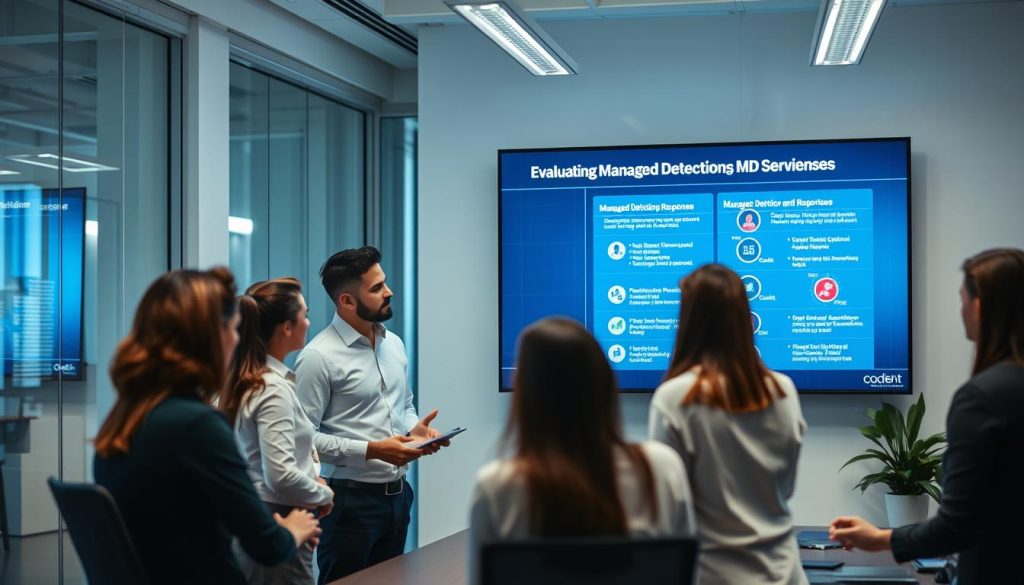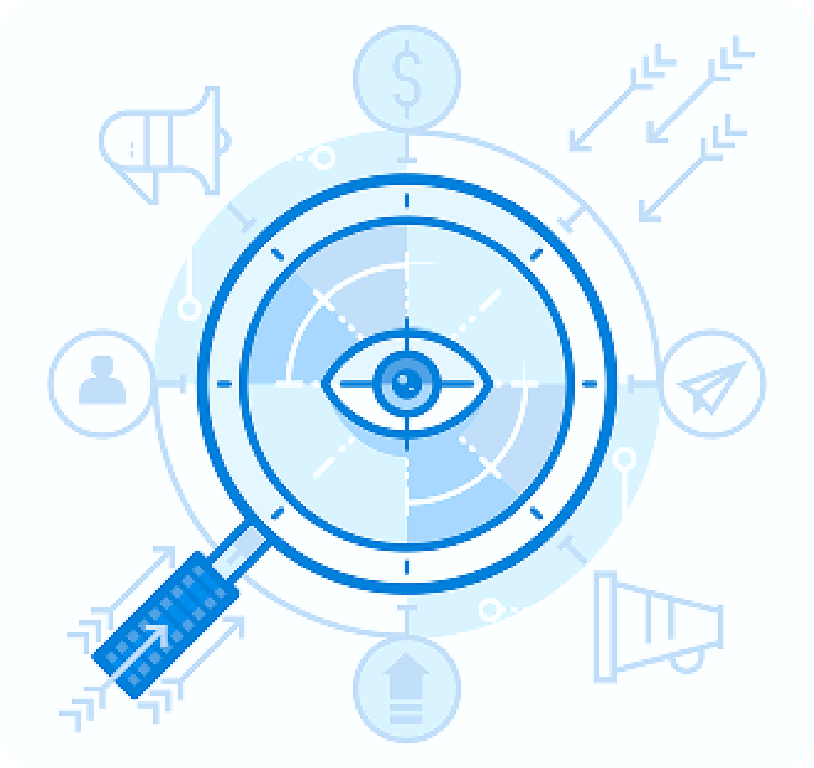Can a single service truly cut mean‑time‑to‑detect and mean‑time‑to‑respond while giving you clear, measurable security outcomes?
We frame this introduction to help leaders sort fact from hype after the June 24, 2024 Gartner Market Guide (authors: Pete Shoard, Mitchell Schneider, Andrew Davies, Angel Berrios, Craig Lawson). The research stresses outcome‑driven MDR that raises verified threat finds while lowering MTTD and MTTR.
Gartner notes consistent visibility to 100+ vendors, while over 600 claim similar offers. That gap matters: it changes how we assess vendor maturity, coverage, automation, and human expertise.
Our focus is practical. We explain why 24×7 SOC coverage, high‑fidelity detections, MITRE ATT&CK performance, and transparent operations (as seen with Bitdefender and Rapid7) should shape procurement and risk choices.

Key Takeaways
- Outcome focus beats feature shopping—prioritize measurable MTTD/MTTR gains.
- Gartner’s June 24, 2024 research clarifies vendor visibility versus vendor claims.
- Look for 24×7 coverage, high‑fidelity pipelines, and proven MITRE results.
- Avoid confusing tools with human‑led operations and transparent playbooks.
- Assess vendors by breadth of coverage, automation, and response speed.
- Use structured criteria to align any selection with your business goals.
Understanding the MDR Landscape in 2024
We view 2024 as a turning point: MDR now ties continuous telemetry to measurable outcomes that cut mean time to contain. The emphasis is on human analysis plus automated triage across endpoints, networks, identities, and cloud.

What Managed Detection and Response Is—and Why Outcomes Matter
MDR blends advanced telemetry with human-led hunting to deliver nonstop detection, triage, investigation, and rapid response. Its value is measured by fewer real threats reaching critical assets and faster containment.
Provider Visibility: 100+ vs 600+
Gartner visibility tracks 100+ providers through client interactions, while over 600 vendors self‑identify as MDR. That gap requires stricter evaluation of coverage, playbooks, and transparency.
| Category | Gartner Visibility | Self-Identified Vendors | Expected Capabilities |
|---|---|---|---|
| Count | 100+ | 600+ | 24×7 SOC, telemetry fusion |
| Transparency | Documented | Varies | Playbooks, data flows |
| Coverage | Verified breadth | Claim-based | Endpoints, cloud, identities |
How the Sector Is Evolving
Providers now add preventative controls and exposure management. That aligns detections to exploitable risks and helps organizations close gaps before incidents escalate.
Market guide for managed detection and response services
If your team misses alerts at night or struggles with noisy telemetry, a provider that blends automation with human hunting can change outcomes.
When MDR fits your organization: limited after-hours coverage, alert fatigue, gaps in threat hunting, or inconsistent incident handling signal a clear need. External partners can accelerate containment while transferring skills.
Core capabilities to expect
- 24×7 monitoring with global SOCs to ensure uninterrupted visibility.
- High-fidelity detections mapped to attacker behavior frameworks to reduce false positives.
- Rapid response with defined containment steps and forensic evidence.
- Proactive threat hunting to find stealthy activity before escalation.
Operating models and transparency
Co-management lets your team retain control while the provider handles monitoring and first-response. Clear playbooks, tool access, and logs enable auditability and collaboration.
Measuring impact
Track baselines for MTTD and MTTR, incident severity trends, false-positive rates, and dwell time. Integrate outputs into ticketing and crisis processes so response actions are executed and verified.
How to Evaluate MDR Providers and Services
We recommend a checklist-driven approach that turns vendor claims into verifiable outcomes. Start by mapping coverage to critical assets and by setting target MTTD and MTTR figures.

A practical evaluation checklist
- Coverage breadth: endpoints, networks, identities, cloud; verify telemetry sources.
- Signal-to-noise: require precision/recall metrics, false-positive rates, analyst-to-alert ratios.
- Automation & technology: automated triage, correlation, APIs, SIEM/XDR integration.
- Expertise & transparency: 24×7 SOC staffing, playbooks, MITRE ATT&CK results (e.g., Bitdefender), and clear post-incident reports (Rapid7 example).
From research to selection
Use gartner research and other publications as directional input. The gartner market guide (authors include Pete Shoard and Mitchell Schneider, published June 24, 2024) notes that visible vendors tend to show outcome focus.
| Evaluation Area | What to Request | Evidence |
|---|---|---|
| Coverage | Telemetry inventory, integration list | Log samples, architecture diagram |
| Detection Quality | Precision/recall, ATT&CK mapping | Test results, MITRE reports |
| Response | Containment playbooks, SLAs | Incident reports, runbooks |
| Commercial Terms | Warranties, data handling, exit criteria | Contracts, pilot metrics |
Conclusion
We urge teams to choose partners that translate telemetry into action and prove they lower risk with evidence, not slogans. A strong.
Use pilots, MITRE-style evaluations, and clear runbooks to verify MTTD and MTTR gains. Prioritize mdr options that combine 24×7 human skill with automated triage and high-fidelity pipelines.
Account for the 600+ vendor claims by keeping a disciplined shortlist. Ask for transparent demos, test data, and contractual commitments that bind product and service promises.
Next steps: document needs, map those to the checklist in this market guide managed overview, run pilots, then select the vendor that demonstrably strengthens your security posture.
FAQ
What is managed detection and response and why should outcomes matter to our organization?
Managed detection and response (MDR) combines continuous monitoring, threat hunting, and incident containment delivered by an external provider. We focus on measurable outcomes—faster mean time to detect (MTTD), reduced mean time to respond (MTTR), and clear coverage across endpoints, cloud workloads, and identity. This outcome focus ensures your security team can prioritize business risk and reduce dwell time for real threats.
How many providers claim MDR capabilities, and does that affect selection?
Over recent years the vendor landscape has expanded significantly, with hundreds of vendors claiming MDR-like offerings. We recommend evaluating visibility, real-world telemetry sources, and independent research (such as analyst publications) rather than relying on claims alone. Broad provider count increases choice but also raises variability in quality and coverage.
How is the MDR space evolving beyond simple detection and remediation?
Leading providers are shifting toward prevention and exposure management. That includes proactive threat hunting, vulnerability-prioritization guidance, configuration hardening, and playbook-driven automation. The shift helps organizations reduce attack surface and prevent repeat incidents rather than only remediating after detection.
When is an MDR solution the right fit for our security operations?
MDR is appropriate when you need 24×7 monitoring, lack staff for continuous threat hunting, or require rapid containment expertise. It also suits organizations seeking co-management with their SOC (security operations center) or those that need to extend coverage to cloud and hybrid environments without large capital investment.
What core capabilities should we expect from a high-quality MDR provider?
Expect continuous monitoring, high-fidelity detections with low false positives, rapid incident response (containment and remediation), proactive threat hunting, and clear reporting on MTTD/MTTR. Providers should deliver transparent playbooks, integration with your SIEM or EDR, and regular operational reviews.
What operating models do vendors offer and how do we choose among them?
Common operating models include fully outsourced MDR, co-managed arrangements, and advisory-led services. Choose based on your internal skill set: fully outsourced if you lack SOC capacity; co-managed if you want tight control and collaboration; advisory if you need targeted expertise and uplift for existing teams.
How should we measure the impact of an MDR engagement?
Track improvements in metrics such as MTTD and MTTR, reduction in successful attacks, volume of false positives, coverage across asset types, and time to containment. Also evaluate qualitative gains like better incident playbooks, staff skill uplift, and operational transparency.
What should be on our evaluation checklist when comparing providers?
Assess coverage breadth (endpoints, cloud, identity), signal-to-noise (detection fidelity), automation capabilities, threat intelligence integration, response SLAs, and the expertise of the human analysts. Verify contractual terms, escalation paths, and data residency or compliance needs.
How do we interpret analyst research and vendor visibility during selection?
Use analyst publications to understand provider positioning, strengths, and gaps, but validate claims through proof-of-concept testing and reference checks. High visibility can indicate maturity, but technical fit and demonstrated outcomes should drive selection.
Can MDR providers help with regulatory and compliance requirements?
Yes. Many providers offer reporting templates, evidence collection for audits, and controls mapping to frameworks such as NIST, ISO, or industry-specific standards. Confirm the provider’s experience with your specific compliance requirements and data handling policies.
How do we ensure transparency into ongoing operations and technology when engaging an MDR vendor?
Require regular operational reviews, access to telemetry summaries, documented playbooks, and integration points with your SIEM or ticketing systems. Insist on dashboards showing detections, response actions, and SLA adherence to maintain trust and clarity.
What risks should we consider when contracting an MDR provider?
Consider vendor lock-in, data access and retention policies, scope gaps (assets not covered), and reliance on proprietary telemetry. Negotiate exit clauses, ensure knowledge transfer plans, and validate contractual guarantees around response times and escalation procedures.






